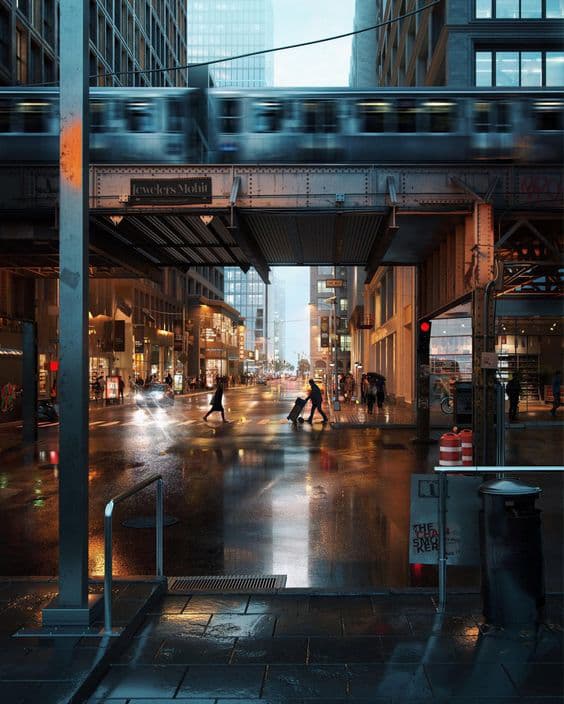The art of digital rendering has transformed the way we visualize urban environments, bringing them to life with stunning realism and atmospheric depth. Among the many techniques used to achieve such vivid representations, the simulation of weather conditions, particularly rain showers, stands out as a remarkable challenge. This article delves into the intricate process of creating an atmospheric urban scene, with a spotlight on perfecting rain showers to enhance the realism and emotional impact of the rendered environment. From gathering inspiration to the final touches in post-production, we’ll guide you through each step necessary to breathe life into urban scenes, making rain a character of its own in the narrative of your render.
Inspiration
Before diving into the technical aspects of rendering, it’s crucial to draw inspiration from the real world and existing art. Observing how rain interacts with urban elements—such as streets, buildings, and lighting—can provide invaluable insights. Photographs of cities during rainstorms capture the way light reflects off wet surfaces, the texture of rain-soaked materials, and the mood created by a cloudy sky. Similarly, examining artworks and cinematic depictions of rainy urban settings can offer creative perspectives on portraying rain atmospherically. This phase is about absorbing the subtleties of rain’s impact on the urban landscape, which will inform the decisions made in subsequent stages of rendering.
3D Modeling
The foundation of any atmospheric urban scene is a solid 3D model. This step involves constructing the urban environment with attention to detail, ensuring that buildings, streets, and other elements are accurately modeled to interact believably with rain. Consideration of how rainwater accumulates, flows, and impacts the urban landscape should influence the modeling process. For instance, modeling slightly uneven streets can allow for realistic puddling and water flow. Additionally, incorporating elements like gutters, downspouts, and drains can add a layer of realism, showing how the environment is designed to handle rainfall.
Texture and Materials
Textures and materials play a pivotal role in conveying the wet, reflective qualities of an urban scene under rain showers. This step focuses on selecting and creating textures that realistically mimic the appearance of wet surfaces, such as glossy asphalt, slick sidewalks, and rain-soaked brick. Reflectivity and bump maps are essential here, as they add depth and realism to surfaces, making them appear wet and reflective. The challenge lies in achieving a balance where the wetness is perceptible but not exaggerated, ensuring materials react to light in a manner consistent with wet conditions.
Lighting
Lighting is arguably one of the most critical elements in creating an atmospheric urban scene with rain showers. The goal is to capture the unique interplay of light with rain and wet surfaces, creating a mood that’s reflective of the scene’s time of day and weather conditions. Key considerations include the soft, diffused light of an overcast sky, the harsh, reflective glare of city lights on wet surfaces, and the subtle luminosity of raindrops themselves. This step requires careful planning and experimentation with light sources to mimic the natural and artificial lighting of an urban rainstorm accurately.
Rendering
With the scene set, textures applied, and lighting adjusted, the rendering process brings the urban landscape to life. This step is where the technical aspects of rendering software come into play, requiring a balance between quality and efficiency. Techniques like ray tracing can be used to accurately simulate light reflection and refraction, essential for creating realistic wet surfaces and raindrops. Additionally, particle systems may be employed to simulate rain falling, adding dynamism and depth to the scene. Rendering settings should be carefully adjusted to capture the fine details of the rain without overwhelming the scene or extending render times excessively.

Post-Production (Main Production)
The final stage, post-production—or as referred to here, the main production—focuses on refining the rendered image to achieve the desired atmospheric effect. This includes adjusting color balance, contrast, and saturation to enhance the mood, as well as adding effects like rain streaks, mist, and puddle reflections that might be difficult to capture during rendering. Software tools allow for the addition of these details, fine-tuning the scene to convey the feeling of a rain-soaked urban environment. This step is also an opportunity to correct any elements that do not look as intended, ensuring the final image is cohesive, atmospheric, and visually compelling.
Conclusion
Creating an atmospheric urban scene, especially one that captures the essence and mood of rain showers, is an intricate process that combines artistry with technical expertise. Each step of this journey—from seeking inspiration and meticulous 3D modeling to the careful application of textures and materials, strategic lighting, detailed rendering, and thoughtful post-production—plays a crucial role in bringing the envisioned scene to life. This article has walked through these essential phases, offering insights and guidelines to help artists and designers achieve a realistic and emotionally engaging portrayal of urban rain.
The art of rendering, particularly when it comes to simulating natural phenomena like rain, demands not only creativity but also a deep understanding of the tools and techniques at one’s disposal. While the process may seem daunting, the outcome—capturing the beauty and atmosphere of a rain-soaked urban landscape—can be immensely rewarding.
However, achieving a high level of realism and atmospheric depth in 3D renderings requires significant time, effort, and specialized skills. For those looking to bring their ideas to life without compromising on quality, seeking the expertise of professional 3D rendering firms is a wise choice. These firms specialize in creating high-quality renderings, leveraging their technical skills, and artistic insight to produce captivating visualizations that meet your specific needs and exceed expectations. By partnering with a professional 3D rendering service, you can ensure that your vision is realized with the utmost attention to detail, from the initial concept to the final atmospheric scene, making your project stand out in its full glory.
